Trier, Images (original) (raw)
.

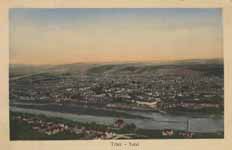
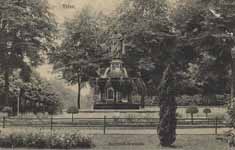
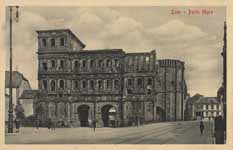
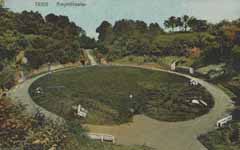
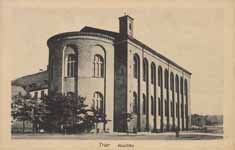

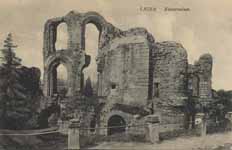
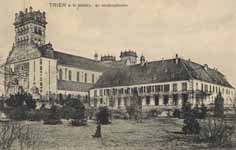
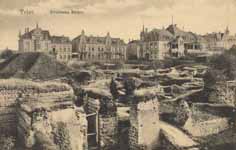
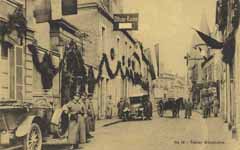
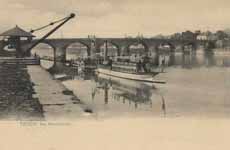
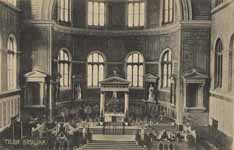
13,
Trier
Trier, historically called in English Treves (German pronunciation: [ˈtʁiːɐ]; French: Trèves, IPA: [tʁɛv]; Luxembourgish: Tréier; Italian: Treviri; Latin: Augusta Treverorum; the Latin adjective associated with the city is Treverensis) is a city in Germany on the banks of the Moselle. It is the oldest city in Germany, founded in or before 16 BC.[2]
Trier lies in a valley between low vine-covered hills of ruddy sandstone in the west of the state of Rhineland-Palatinate, near the border with Luxembourg and within the important Mosel wine region.
The city is the oldest seat of a Christian bishop north of the Alps. In the Middle Ages, the Archbishop of Trier was an important prince of the church, as the Archbishopric of Trier controlled land from the French border to the Rhine. The Archbishop also had great significance as one of the seven electors of the Holy Roman Empire.
With an approximate population of 105,000 Trier is ranked fourth among the state's largest cities; after Mainz, Ludwigshafen, and Koblenz.[3] The nearest large cities in Germany are Saarbrücken, some 80 km southeast, and Koblenz, about 100 km northeast. The closest city to Trier is the capital of Luxembourg, some 50 km to the southwest.
Trier is home to the University of Trier, the administration of the Trier-Saarburg district and the seat of the ADD (Aufsichts- und Dienstleistungsdirektion), which until 1999 was the borough authority of Trier, and the Academy of European Law (ERA). It is one of the five "central places" of the state of Rhineland-Palatinate. Along with Luxembourg, Metz and Saarbrücken, fellow constituent members of the QuattroPole union of cities, it also forms a central place of the greater region encompassing Saar-Lor-Lux (Saarland, Lorraine and Luxembourg), Rhineland-Palatinate, and Wallonia.
History
Main article: History of Trier
The Porta Nigra
According to the Gesta Treverorum, the city was founded by Trebeta, an Assyrian prince, centuries before ancient Rome. He was the son of Ninus, King of Assyria, by a wife prior to his marriage to Queen Semiramis. His stepmother, Semiramis, despised him and when she took over the kingdom after the death of his father, Ninus, Trebeta left Assyria and went to Europe. After wandering for a time, he led a group of colonizers to settle at Trier around 2000 BC in what is now Germany. Trebeta is also reputed to have been at Strasbourg, France. Upon his death, his body was cremated on Petrisberg by the people of Trier.
The Roman Empire subdued the Treveri in the 1st century BC and established Augusta Treverorum (Lit: August (Regal, noble) [City] of the Treveri) in 30 BC. The name is likely to be taken from the title Augustus held by the Princeps or head of state at the time, Augustus Caesar. The city later became the capital of the Roman province of Gallia Belgica, as well as the Roman prefecture of Gaul. It covered 700 acres (283.28 ha) within its walls and may have had as many as 70,000 inhabitants. The Porta Nigra is counted among the Roman architecture of the city. A residence of the Western Roman Emperor, Roman Trier was the birthplace of Saint Ambrose. Sometime between 395 and 418 the Roman administration moved the staff of Pretorian Prefecture from the city to Arles. The city continued to be inhabited, but was not as prosperous as before, because of the absence of 2,000 staff members of the Prefecture and military. However, the city remained the seat of a governor and had state factories for the production of ballistae and armor, and a wool mill for uniforms for the troops, clothing for the civil service and high-quality garments for the Court. Northern Gaul was held by the Romans along a line from north of Cologne to the coast at Boulogne through what is today southern Belgium until 460. South of this line, Roman control was firm, as evidenced by the continuing operation of the imperial arms factory at Amiens.
The Franks seized Trier from Roman administration in 459 AD. In 870, it became part of Eastern Francia, which developed into the Holy Roman Empire. Relics of Saint Matthias brought to the city initiated widespread pilgrimages. The bishops of the city grew increasingly powerful and the Archbishopric of Trier was recognized as an electorate of the empire, one of the most powerful states of Germany. The University of Trier was founded in the city in 1473.
The Cathedral of Trier
In the 17th century, the Archbishops and Prince-Electors of Trier relocated their residences to Philippsburg Castle in Ehrenbreitstein, near Koblenz. A session of the Reichstag was held in Trier in 1512, during which the demarcation of the Imperial Circles was definitively established.
In the 17th and 18th centuries, Trier was sought after by France, who invaded during the Thirty Years' War, the War of the Grand Alliance, the War of the Spanish Succession, and the War of the Polish Succession. France succeeded in finally claiming Trier in 1794 during the French Revolutionary Wars, and the electoral archbishopric was dissolved. After the Napoleonic Wars ended in 1815, Trier passed to the Kingdom of Prussia. Karl Marx was born in the city in 1818.
Palace of Trier
As part of the Prussian Rhineland, Trier developed economically during the 19th century. The city rose in revolt during the revolutions of 1848 in the German states, although the rebels were forced to concede. It became part of the German Empire in 1871.
In June 1940 over 60,000 British prisoners of war, captured at Dunkirk and Northern France, were marched to Trier, which became a staging post for British soldiers headed for German prisoner-of-war camps. Trier was heavily bombed and bombarded in 1944 during World War II. The city became part of the new state of Rhineland-Palatinate after the war. The university, dissolved in 1797, was restarted in the 1970s, while the Cathedral of Trier was reopened in 1974. Trier officially celebrated its 2,000th anniversary in 1984.
Geography
View of the city from the Mariensäule monument.
Trier sits in a hollow midway along the Moselle valley, with the most significant portion of the city on the east bank of the river. Wooded and vineyard-covered slopes stretch up to the Hunsrück plateau in the south and the Eifel in the north. The border with the Grand Duchy of Luxembourg is some 15 km distant.
Neighbouring municipalities
Listed in clockwise order, beginning with the northernmost; all municipalities belong to the Trier-Saarburg district
Schweich, Kenn and Longuich (all part of the Verbandsgemeinde Schweich an der Römischen Weinstraße), Mertesdorf, Kasel, Waldrach, Morscheid, Korlingen, Gutweiler, Sommerau and Gusterath (all in the Verbandsgemeinde Ruwer), Hockweiler, Franzenheim (both part of the Verbandsgemeinde Trier-Land), Konz (Verbandsgemeinde Konz), Igel, Trierweiler, Aach, Newel, Kordel (Eifel), Zemmer (all in the Verbandsgemeinde Trier-Land)
Organization of city districts
The Trier urban area is divided into 19 city districts. For each district there is an Ortsbeirat (local council) of between 9 and 15 members, as well as an Ortsvorsteher (local representative). The local councils are charged with hearing the important issues that affect the district, although the final decision on any issue rests with the city council. The local councils nevertheless have the freedom to undertake limited measures within the bounds of their districts and their budgets.
The districts of Trier with area and inhabitants (December 31 2009):
Official district number District with associated sub-districts Area
in km² Inhabitants
11 Mitte/Gartenfeld 2.978 11,954
12 Nord (Nells Ländchen, Maximin) 3.769 13,405
13 Süd (St. Barbara, St. Matthias or St. Mattheis) 1.722 9,123
21 Ehrang/Quint 26.134 9,195
22 Pfalzel 2.350 3,514
23 Biewer 5.186 1,949
24 Ruwer/Eitelsbach 9.167 3,091
31 West/Pallien 8.488 7,005
32 Euren (Herresthal) 13.189 4,207
33 Zewen (Oberkirch) 7.496 3,634
41 Olewig 3.100 3,135
42 Kürenz (Alt-Kürenz, Neu-Kürenz) 5.825 8,708
43 Tarforst 4.184 6,605
44 Filsch 1.601 761
45 Irsch 4.082 2,351
46 Kernscheid 3.768 958
51 Feyen/Weismark 5.095 5,689
52 Heiligkreuz (Alt-Heiligkreuz, Neu-Heiligkreuz, St. Maternus) 2.036 6,672
53 Mariahof (St. Michael) 7.040 3,120
Totals 117,210 105,076
Main sights
Roman Monuments,
Cathedral of St. Peter
and Church of Our Lady in Trier *
UNESCO World Heritage Site
Trier Kaiserthermen BW 1.JPG
Country Germany
Type Cultural
Criteria i, iii, iv, vi
Reference 367
Region ** Europe and North America
Inscription history
Inscription 1986 (10th Session)
* Name as inscribed on World Heritage List
** Region as classified by UNESCO
Trier is well known for its well preserved Roman and medieval buildings, which include:
the Porta Nigra, the best preserved Roman city gate north of the Alps;
ruins of three Roman baths, among them the largest Roman baths north of the Alps;
the huge Constantine Basilica, a basilica in the original Roman sense, was the 67 m (219.82 ft) long throne hall of Roman Emperor Constantine; it is today used as a Protestant church.
the Trier Cathedral (German: Trierer Dom or Dom St. Peter), a Roman Catholic church which dates back to Roman times and is home to the Holy Tunic, a garment with a recorded history back to the 12th century, in Catholic tradition said to be the robe Jesus was wearing when he died. It is only exhibited every few decades, at irregular intervals.
The Liebfrauenkirche (German for Church of Our Lady), which is one of the most important early Gothic cathedrals in Germany and falls into the architectural tradition of the French Gothic cathedrals;
the Roman amphitheatre;
the 2nd century AD Roman bridge (Römerbrücke) across the Moselle, the oldest bridge north of the Alps still crossed by traffic;
St. Matthias' Abbey (Abtei St. Matthias), a still-in-use monastery in whose medieval church the only apostle north of the Alps is held to be buried
St. Gangolf Church was the city's market church that rivalled the Archbishop's Trier Cathedral.
Saint Paulin Church, one of the most important Baroque churches in Rhineland-Palatinate and designed in part by the architect Balthasar Neumann
two old treadwheel cranes, one being the Gothic "Old Crane" (Alte Krahnen) or "Trier Moselle Crane" (Trierer Moselkrahn) from 1413, and the other the 1774 Baroque crane called the "(Old) Customs Crane" ((Alter) Zollkran) or "Younger Moselle Crane" (Jüngerer Moselkran) (see List of historical harbour cranes)
The old Jewish cemetery (DE) (Weidegasse)
Judengasse- near the Trier Hauptmarkt (main market) the Jewish quarter of the city in the Middle Ages.
Museums
Rheinisches Landesmuseum (one of the two most important German archaeological museums for the Roman period, along with the Römisch-Germanisches Museum in Cologne)
Stadtmuseum Simeonstift (history of Trier, displaying among other exhibits a model of the medieval city)
Bischöfliches Dom- und Diözesanmuseum (Museum of the Diocese of Trier, displays also numerous Roman artefacts)
Toy Museum of Trier
Ethnological and open air museum Roscheider Hof, a museum in the neighboring town of Konz, right at the city limits of Trier, which shows the history of rural culture in the northwest Rhineland Palatinate and in the area where Germany, Luxembourg and Lorraine meet.
Fell Exhibition Slate Mine; site in the municipality of Fell, 20 kilometers from Trier, containing an underground mine, a mine museum, and a slate mining trail.
Karl Marx House; a museum exhibiting Marx's personal history, volumes of poetry, original letters, and photographs with personal dedications. There is also a collection of rare first editions and international editions of his works, as well as exhibits on the development of socialism in the 19th century.
Education
Trier is home to the University of Trier, founded in 1473, closed in 1796 and restarted in 1970. The city also has the Trier University of Applied Sciences. The Academy of European Law(ERA) was established in 1992 and provides training in European law to legal practitioners. In 2010 there were about 40 Kindergärten,[4] 25 primary schools and 23 secondary schools in Trier, such as the Humboldt Gymnasium Trier, Max Planck Gymnasium and the Pestalozzi-Hauptschule.[5]
Annual events
Every summer Trier hosts Germany's biggest Roman festival, Brot und Spiele (German for Bread and Games).
Trier has been the base for the German round of the World Rally Championship since 2000, with the rally's presentation held next to the Porta Nigra.
Trier holds a lavish Christmas street festival every year called the Trier Christmas Market on the Hauptmarkt (Main Market Square) and the Domfreihof in front of the Cathedral of Trier.
Transportation
Trier station has direct railway connections to many cities. The nearest cities by train are Cologne, Saarbrücken and Luxembourg. Via the motorways A 1, A 48 and A 64 Trier is linked with Koblenz, Saarbrücken and Luxembourg. The nearest commercial (international) airports are in Luxembourg (0:40 h by car), Frankfurt-Hahn (1:00 h), Saarbrücken (1:00 h), Frankfurt (2:00 h) and Cologne/Bonn (2:00 h). The Moselle River is an important waterway and is also used for river cruises.
Sports
Major sports clubs in Trier include:
FSV Trier-Tarforst, intera alia football and rugby
SV Eintracht Trier 05, association football
TBB Trier, basketball
DJK/MJC Trier, women's team handball
Trier Cardinals, baseball
PST Trier Stampers, American Football
Renn Center Trier, Slotcar
Notable residents
see Heinz Monz: Trierer Biographisches Lexikon. Landesarchivverwaltung Rheinland-Pfalz, Koblenz 2000. 539 p. ISBN 3931014495.
Eucharius (died ~250), first bishop of Trier
Valerius (†320), second bishop of Trier
Helena (ca. 250-330), saint, mother of Constantine the Great[6]
Paulinus (†358), bishop of Trier
Valentinian I (321–375), Roman emperor
Ausonius (ca. 310–395), Roman consul and poet
Ambrose (ca. 340–397), saint
Kaspar Olevianus (1536–1587), theologian
Karl Marx (1818–1883), social philosopher
Frederick A. Schroeder (1833–1899), American politician, mayor of Brooklyn
Ludwig Kaas (1881–1952), Roman Catholic priest and politician of the Zentrum
Oswald von Nell-Breuning (1890–1991), theologian
Wolf Graf von Baudissin (1907–1993), general, military planner and peace researcher
Xavier Bout de Marnhac (born 1951), French general, former commander of KFOR
Robert Zimmer (philosopher) (born 1953), German philosopher and essayist
Ernst Ulrich Deuker (born 1954), musician of Ideal
Guildo Horn (born 1963), singer
Eric Jelen (born 1965), tennis player
Martin Bambauer (born 1970), church musician
Josephine Henning (born 1989), footballer
Gary Bingham (1993) snowboarder
International relations
Trier is a fellow member of the QuattroPole union of cities, along with Luxembourg, Saarbrücken, and Metz (neighbouring countries: Luxembourg and France).
Twin towns – Sister cities
See also: List of twin towns and sister cities in Germany
Trier is twinned with:
France Metz, France since 1957
United Kingdom Gloucester, United Kingdom, since 1957
Italy Ascoli Piceno, Italy, since 1958
Netherlands 's-Hertogenbosch, Netherlands, since 1968
Croatia Pula-Pola, Croatia, since 1971
United States Fort Worth, Texas, USA since 1987
Germany Weimar, Germany since 1990
Japan Nagaoka, Japan, since 2006
China Xiamen, China, since 2010
Namesakes
United States New Trier Township, USA, originally settled by people from Trier.
United States New Trier, USA, settled by people from Trier about 1856.
Gallery
Old Jewish cemetery
St. Gangolf church
Trier Zurlauben
References
^ "Bevölkerung der Gemeinden am 31.12.2010" (in German). Statistisches Landesamt Rheinland-Pfalz. 2011.
^ Website of the Municipality of Trier
^ "Bevölkerung der Gemeinden am 31.12.2010" (in German). Statistisches Landesamt Rheinland-Pfalz. 2011.
^ Kindergärten in Trier
^ Schulen in Trier
^ http://www.heiligenlexikon.de/CatholicEncyclopedia/Helena.html
From Wikipedia, All text is available under the terms of the GNU Free Documentation License